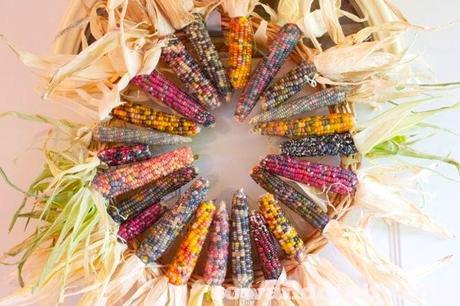The kingdom of plants in nature is a kaleidoscope of hybrids, gene grafts and reshuffles to make the Greek myth of the chimeras pale. The maize (Zea mays), however, of all plants he is keen to show off as a champion of genetic exhibitionism.
The cobs that we find in the supermarket are usually beautiful canary yellow, or more tending towards orange or gold, anyway on those shades. Some of you, however, may have happened to find even some corn on the cob “alternative”, brown for example, o carbone, or yellow in colour, alternating brown and brown:
Contrary to common belief, the corn is not in a standard way “giallo”. However, tomatoes aren't just red either [1] or carrots only orange [2]. The corn though, as we will see shortly, he exaggerates a little and knows how to go much further in the colors.
Here in Italy, for example, the Biancoperla and Ottofile di Antignano varieties are grown:
Each grain of corn consists of a small “fruit”, called by botanists cariosside, which once it has reached maturity it does not open to disclose its single large and hard seed, called germ (or embryo). The two are fused in such a way that it is difficult to conceive of them separately. Everything is fine “fruit” it comes from a single ovary and always, as botanists teach us, it is made up, simplifying, from three main layers: around pericarpo which covers the entire kernel; the endosperm inside where starch and protein accumulate; finally the stretching in the heart of the grain, precisely.
The color of the grain is due to the presence of pigments which accumulate above all on the inside, but to a certain extent also in the thin outer layer.
When we see cobs with colors that go from sandy yellow to bronze or orange/reddish, this is mainly due to a type of pigment known as carotenoids [3], of which a very common exponent in corn is a nice molecule called zeaxanthin [4].
There are other pigments as well, like them anthocyanins (which give shades from pink to purple to violet) i flobafeni (which are on red and magenta).
If you remember the previous installments of our history of genetics [5], you should remember that the characteristics of an organism, such as the production of a particular pigment, they correspond to the action of one or more genes inherited following particular laws (with their exceptions), like those of Mendel. For each character for which these genes “they encode” there are varieties called alleles (for example, two different colors for flowers or seeds) and they, geneticists tell us, they may or may not express themselves.
Pigments can overlap each other, as in a painter's palette. Let's imagine for example that the thin pericarp produces a hint of red, while the endosperm of yellow in abundance, we will see some amber grains.

As already mentioned, each grain comes from a single ovary of the plant. They are genetically distinct from each other, as well as all of a person's eggs or sperm cells. If you pass the comparison, the corn kernels are all a bit’ like heterozygous twins. And just as two brothers can have different colored eyes or hair, even corn kernels can have different colors on the same cob.
This explains why we have charcoal cobs in the examples above, whitish panicles, golden yellow cobs, but also cobs with alternating grains: sand, bruni, making the areas much more permeable and subject, orange and so on. Each grain has its own genes and alleles, perhaps it was also fertilized by pollen from another plant, so in the midst of so many brown grains some blonds can jump out.
In all that we have said, however, one more factor must be added: the so-called “transposable gene elements”
The researcher who discovered these elements is very famous among biologists in general, but quite unknown outside the environment: Barbara McClints. She in the 50s, in an era of great ferment for genomic studies (the structure of DNA would soon be modeled), at the Carnegie Institute, he was analyzing the chromosomes of a particular corn on slides: the grains did not have a uniform colour, they had patches or “splash” of various pigmentation in a whitish field (or better, colorless), or the opposite (colorless splashes on a colored background).
Here's an example, in the variety of corn Catseye:
Barbara noticed that, from generation to generation, the chromosomes appeared to vary slightly in size, hand in hand with the changes in the spots of the beans.
It was systematic: the “arms” of the chromosomes varied in length when the spots appeared, as if a piece had been added, which evidently must have contained a gene responsible for “stain”. To every generation, these fragments break away from their DNA position, as if they were cut by scissors, to then be stitched together in other points of the DNA where they continue to express their functions.
Barbara called these geniuses transposons and it was a revolution because until then geneticists were firmly convinced that genes remain immobile in the chromosome [6].
But these moves were not arbitrary, but they were commanded by another gene, which the researcher called Ac (for activator). The first one instead called him Ds (dissociator), because it could occasionally fit into the same place as another C gene (color) deactivating it.
Barbara did not yet know the structure and composition of DNA, but genes are made up of a whole row of molecules in sequence, this nucleoside. They exist 4 types and their combinations, a bit’ like the letters of the alphabet, can give rise to various “parole” genetics that correspond to the expression of a character (such as the production of a protein).
Transposons are basically other words that are inserted in the middle of a sentence, nullifying its meaning. A bit’ as if “sky blue” would become “azzrossourro”. When in McClintock's corn a Ds “transposed” (that is, it moved) within a C gene, no color was produced.

But when that didn't happen, here the gene could express itself and produce the pigment in that cell. This could have happened early in the development of the germ, when all the rest of the grain still has to form, but it could also happen later in a random cell that had already emerged. The cell in turn multiplies, by distributing its gene in an area of grain of daughter cells obtained by cell division from a single one “madre”.
Or, if the transposon is inserted at the beginning of the development of the germ, while the grain is still growing, some cells may see their transposons jump further the other way, reactivating the production of color in some areas of a pale grain.
This is how the presence of pigmented spots in the grains is explained.
Between the lines it is understood that a transposon could remain and silence the genes of a pigment from the beginning, completely preventing it from being produced. Many varieties of corn vary in color in the kernels also because transposons prevent a certain pigment from being expressed, to then maybe in the next generation turn everything upside down. Barbara also noticed similar changes between generations in her cobs.
By silencing the production of all carotenoids, the endosperm should be pale. Unless phlobaphenes and anthocyanins are produced in abundance, giving different results from grain to grain.
If the phlobaphenes are expressed in an overflowing way, both in the endosperm and in the pericarp, while the rest are muted, we can get the variety first Cranberry say but:
And then there First, decidedly dark:
If the endosperm instead produces yellow/orange in abundance while the pericarp lays purple phlobaphenes on it, we will get variety Go-Blue say but:
Occasionally, transposons could silence the genes responsible for the production of phlobaphenes, making the seeds yellow again:

But squaw. How many of you before reading this article would have thought this is strange, fault or something?
Corn can truly be an artist in its own way and can manifest a very wide range of colors simultaneously, like blue, rosso, viola, rosa, green… be translucent or opaque, bright or dull, and play a bit’ the Harlequin of the vegetable kingdom.
This variety of corn hereinafter is called glass gem (“glass gem corn”) and the grains look like pieces of colored glass. This type of corn was obtained, after a patient and laborious work of selection and crossbreeding, by an American farmer, Carl Barnes, of Cherokee descent [8]:
Plants are not the only ones to possess transposons. Human beings have them too [9]. And microorganisms too, including many pathogens, who exploit the “gene jump” to escape the immune system and propagate its own genome.
A classic example is Neisseria gonorrhoeae, unwelcome guest of our private parts. But in the field of biotechnology, when it comes to “move the DNA”, more than the transposons, the plasmids are known, like the one of Agrobacterium tumefaciens, which similarly insert into DNA and which are used in genetic engineering to insert genes of interest.
But we will talk about this another time.

Further details:
Anthony J.F. Griffiths et al. – Genetics, principles of formal analysis
Walker Wilson – Biochemistry and molecular biology
Michael J. Simmons – Principles of genetics
Chromosomes are DNA molecules compacted in such a way as to facilitate this partitioning. Russel – Genetics, a molecular approach
Note:
[1] IxS – The sea bream apple that founded Italian gastronomy (http://italiaxlascienza.it/main/2014/08/la-mela-dorata-che-da-oltre-le-colonne-dercole-ha-fondato-la-gastronomia-italiana/)
[2] Dario Bressanini – Biodiverse carrots (http://bressanini-lescienze.blogautore.espresso.repubblica.it/2011/12/12/carote-biodiverse/)
[3] The name comes precisely from the carrot, which owes its color to them. To this class of pigments also belongs the beta-carotene (acronym as an additive E160a), from the skin derives retinoic acid or vitamin A (essential for the organism), no less important for the coloring of the corn. Or egg yolk. Or citrus fruits. Or various food products. Carotenoids are also used by plants to perform photosynthesis at a different light spectrum than chlorophyll (protecting it also from the most energetic rays and from oxidation) and I'm what's left when the leaves turn yellow or red in autumn.
[4] to be precise the zeaxanthin it's a xanthophyll, a subclass of carotenoids, yellow-orange in color and equally widespread as corn pigment (from which it takes its name), egg, fruits and in the food industry (E161h) and cosmetics.
[5] Minerva – The history of genetics, part 1 (http://noidiminerva.wordpress.com/2013/11/08/la-storia-della-genetica-1-mendel-e-leredita-dei-caratteri/)
[6] At the beginning of Barbara's studies, however flawless, they were not very accepted, also because the other laboratories struggled to recognize the changes in the length of the chromosomes that the American was able to notice, but in a few years they had to admit the existence of transposons and Barbara was awarded a well-deserved Nobel Prize.
[7] The corn we find in the supermarket is let's say one “forcing” component, in which grains capable of producing yellow carotenoids and nothing else have been selected, to give a uniform colour. Actually the multicolour varieties (apart from it glass gem) they are much more “originals”.
[8] http://www.nativeseeds.org/community/199-the-story-of-glass-gem-corn-beauty-history-and-hope





















Leave A Comment